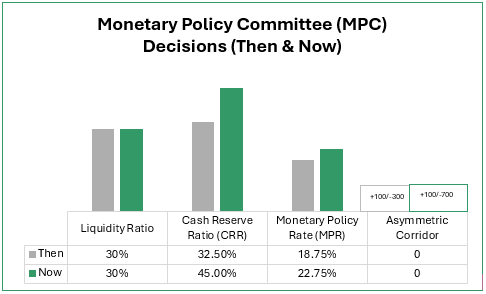Introduction
It is a routine for the Central Bank of Nigeria (CBN) to review rates from time to time; this is not an anomaly – it is best that I establish this fact so that it does not seem like what the CBN has done is unusual. However, this is the first time that rates are this high in Nigeria. The new CBN rates as shown in Figure 1 below highlights significant changes that have taken place and the policy directions of the new CBN, led by Mr. Olayemi Cardoso.

Interpretation of the CBN’s Reviewed Interest Rates
Generally, the rates impact the availability and accessibility of money (lending, borrowing) in Nigeria. They pretty much determine how much you pay to ‘borrow’ money and how much you get when you ‘invest’ your money.
Specifically, for Micro, Small, Medium-sized enterprises (MSMEs), the MPR (Monetary Policy Rate) is the most significant, because the other rates directly impact Deposit Money Banks (DMBs) more than businesses. In simple terms, as a business owner or manager, you cannot access funds (except for special alternatives, which is not covered in this article) at interests less than 22.75%.
CBN’s Reviewed Interest Rates: Practical Implications for Existing Borrowings
Given the inevitability of credit (debts, borrowings) and its attendant interest overlay, MSMEs should begin to prepare for notifications from their Creditors (payables). Facilities obtained from regulated financial institutions are subject to these changes based on the agreed terms and conditions.
Managers and owners of MSMEs should review their terms and conditions to see if the new rates are applicable. It is likely that general purpose facilities are affected. However, specialised facilities such as those obtained from the Bank of Industry or other special sources may not be affected. These terms are clearly spelt out in the conditions signed before obtaining the loans.
Managers and owners of MSMEs may need expert advice to know how to respond to their creditors. But here, I give general advice:
1. Refrain from Panicking
This news comes at a time that the economic landscape does not make businesses looks good – rising costs, loss of labour, increasing compliance costs amongst others. Human instinctive response might be panic, but this is not the time for panic at all.
Rather, panic can aggravate your emotional condition and lead to depressive behaviours. It is best to remain calm, albeit this is easier said than done. This news will definitely draw from your emotional bank and support systems.
If you have a strong one in place, the impact will be minimal. If you have a low deposit in your emotional bank or a weak support system, you might feel the impact more, but all is not lost as you can quickly ‘buy’ some deposits. I trust that there are mental health specialists that are willing and able to help you through this times.
2. Respond to your Creditor’s Communications
Non-response will not make the ‘problem’ go away. It is better to keep the lines of communication open. You started on a good note with your Creditor, don’t break that relationship because of this situation – it will pass and when you look back afterwards, you will be glad you handled it better than using abandonment.
I would therefore recommend that you respond to emails, calls and other means of communication. Let them know that you honour their relationships even if you are immediately unable to meet their new demands.
3. Restructure Existing Borrowings
Most Creditors should be open to a restructuring especially if the new rates apply to the existing facilities. Even if they do not necessarily apply, it is better to restructure your borrowings if you can.
CBN’s Reviewed Interest Rates: Practical Implications for New Borrowings
This is as clear as noon day. What this means for new borrowings is that accessing loans will now come at the new rates. General purpose facilities will now go for 22.75% plus management fees and other fees. This implies that around ₦300,000.00 will be required as interest on a facility of ₦1,000,000.00 (this is only a simplification of the calculation). It is best to look out for the nitty-gritty of terms e.g., straight line or reducing balance rates, annual or monthly rates etc. so that businesses can easily prepare their cash budget to meet these obligations.
A general note of advice to managers and owners of MSMEs is to determine the suitability and sustainability of this rate on their operations. If this new rate is too high for the type of business, it is better to either stay off new borrowings or source alternatives.
CBN’s Reviewed Interest Rates: Practical Implications for Excess Liquidity
Some businesses might be struggling to survive in this economy, while some might have excess liquidity. It is not business wise to keep excess liquidity in a business, hence businesses with excess liquidity can take advantage of this time to invest and get better returns. How then can a business know that it has excess liquidity?
Liquidity is not just having money in the business account. From the bookkeeping perspective, there are two main methods used to determine liquidity. Please note that there is a significant difference between liquidity and profitability. Interestingly, there is a paradoxical relationship between both such that a business can be profitable but not liquid and another can be liquid but not profitable. Alternatively, a business can be both liquid and profitable while another can be both illiquid and unprofitable, but that is not the focus of this article.
- Current ratio is preferred if most of the items included are significantly liquid.

- The Acid-test ratio takes away the value of inventory because inventory might be difficult to convert to cash and cash equivalents.

N/B: Current assets are assets that accrue to a business in the short term (less than or equal to 12 months) and they include inventory, receivables, prepayments (advance), cash and bank balances.
Current liabilities are obligations that fall due in the short term such as interest payments, overdrafts, payables amongst others.
Conclusion
According to the CBN, this measure is to tighten some monetary indices and strain inflation. It is believed in economic circles that this decision is not for the long run, however, it is best that businesses are re-strategic about their choices, practices, and processes.
Cost control and cost reduction come in handy where applicable. As is often said, innovation is a child of necessity or that necessity is the mother of innovation. It is time for businesses to look inwards, outwards, and everywhere else for innovative solutions to help them remain in business and continue to do what they love to do, not just for the money, but for the impact that it creates.
Where possible, managers and business managers should consider limiting new borrowings or focus on alternative borrowings.
I earnestly desire to see your business out-strive this phase.

